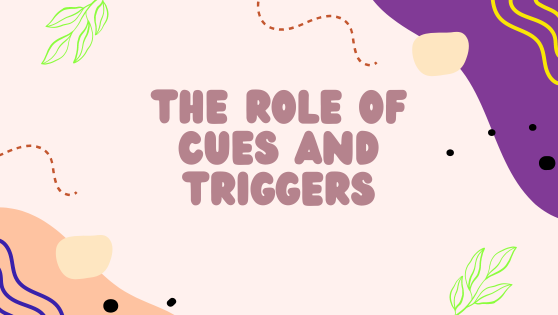Understanding and mastering habit cues and triggers is essential for developing and maintaining positive habits. Cues and triggers are the subtle signals that prompt us to take action, and harnessing their power can make habit formation much more manageable. This article delves into the concept of habit cues and triggers, providing seven expert tips to help you use them to your advantage and achieve effortless change.

1. Understand the Role of Cues and Triggers
Cues and triggers are the foundation of habit formation. They are the signals that tell your brain to initiate a specific behavior. Recognizing and understanding these elements is the first step to mastering them.
The Basics of Cues and Triggers:
– Cues: These are the prompts that trigger a habitual behavior. They can be external (like a time of day or location) or internal (like an emotional state).
– Triggers: Triggers are the specific events or conditions that activate the habit loop. They are often closely linked to cues and can be used interchangeably in this context.
2. Identify Your Existing Cues
Before you can effectively use cues to form new habits, you need to identify the ones that already exist in your daily routine. This awareness helps you understand your current behavior patterns.
Identifying Existing Cues:
– Track Your Habits: Keep a log of your daily habits and the circumstances around them. Note the time, location, emotional state, and preceding actions.
– Look for Patterns: Review your log to find recurring cues. Understanding these patterns can help you leverage them for new habits.
– Reflect on Triggers: Think about what prompts your current habits. Are there specific times of day, places, or feelings that consistently lead to certain behaviors?
3. Use Visual Cues to Reinforce Positive Habits
Visual cues are powerful tools for habit formation. By placing visual reminders in your environment, you can trigger desired behaviors more easily.
Implementing Visual Cues:
– Sticky Notes: Use sticky notes with reminders of your goals and place them where you’ll see them often, like on your computer or refrigerator.
– Habit Trackers: Create a visual habit tracker and display it prominently. Marking off each day you complete a habit can be highly motivating.
– Environment Design: Arrange your environment to make desired behaviors more visible. For instance, keep healthy snacks on your kitchen counter and hide junk food.
4. Leverage Time-Based Cues
Time-based cues are highly effective because they integrate new habits into your daily schedule. Associating habits with specific times of the day helps create consistency.
Using Time-Based Cues:
– Set Alarms: Use alarms or notifications to remind you of your new habits at designated times.
– Daily Routines: Incorporate new habits into your existing routines. For example, meditate right after brushing your teeth in the morning.
– Consistency is Key: Aim to perform your new habit at the same time every day. This regularity strengthens the association between the cue and the habit.
5. Create Emotional Triggers for Powerful Habits
Emotions are strong drivers of behavior. By associating positive emotions with your new habits, you can make them more appealing and easier to maintain.
Creating Emotional Triggers:
– Positive Reinforcement: Reward yourself immediately after completing a new habit. This positive reinforcement strengthens the emotional connection.
– Visualize Success: Spend a few minutes visualizing the positive outcomes of your new habit. This mental practice can evoke the emotions associated with success.
– Anchor to Positive Feelings: Associate your new habit with an activity or memory that makes you feel good. For instance, listen to your favorite music while exercising.
6. Utilize Contextual Triggers
Contextual triggers are cues based on your environment or specific situations. They can be incredibly effective for establishing new habits.
Implementing Contextual Triggers:
– Environmental Changes: Modify your environment to trigger desired behaviors. For example, leave your workout clothes out the night before to prompt morning exercise.
– Situation-Based Habits: Link your habits to specific situations. For instance, drink a glass of water every time you return home from work.
– Context Matters: Be mindful of how different contexts can affect your habits. Adjust your environment to support positive behaviors and reduce negative ones.
7. Plan for Habit Disruptions
Life is unpredictable, and disruptions are inevitable. Planning for these disruptions ensures you stay on track with your habits even when things don’t go as planned.
Planning for Disruptions:
– Identify Potential Obstacles: Think about situations that might disrupt your habit cues and triggers. Plan how you will handle these obstacles.
– Have Backup Plans: Develop alternative cues and triggers for when your primary ones aren’t feasible. Flexibility is key to maintaining consistency.
– Stay Adaptable: Be willing to adjust your strategies as needed. Adaptability helps you stay committed to your habits despite challenges.
Conclusion
Mastering habit cues and triggers is essential for effortless habit formation and maintenance. By understanding their role, identifying your existing cues, and strategically implementing visual, time-based, emotional, and contextual triggers, you can create a robust framework for lasting change. Additionally, planning for disruptions ensures you stay on track even when faced with challenges.
Embrace these strategies to harness the power of habit cues and triggers, and watch as your desired behaviors become automatic and ingrained in your daily routine. With consistency and persistence, you’ll achieve your goals and experience the transformative impact of well-established habits.